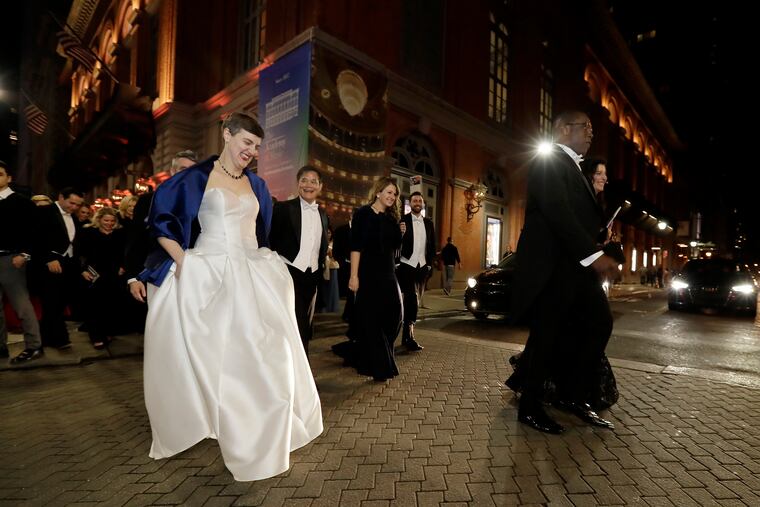Why Academy Ball organizers are smart to reevaluate the event | Elizabeth Wellington
Rethinking the ball is a smart idea if for no other reason than the city’s crown jewel events is acknowledging the fact that it needs to do more than invite Jill Scott to perform to prove it’s still relevant.

Leaders of the Academy of Music and the Philadelphia Orchestra announced last week they were putting the annual ball and concert on pause.
After the last ball’s lackluster attendance — and humdrum haute couture — organizers told my colleague Peter Dobrin it was time to rethink things. “We are going to take this pause and evaluate,” said Academy chair Caroline B. “Cackie” Rogers. “Our net and our gross have been going down, and ticket sales have gone down a bit, and costs, like everything else, have gone up.”
Can’t say I blame them.
This is not a reflection of the Academy. For decades, the annual ball and concert has been one of the city’s most successful charitable soirees. Over the decades, it has raised millions of dollars for the constant renovations and restorations of the Academy of Music.
The arts are important. The arts are expensive. Someone has to pay for them.
But the Academy Ball wasn’t just a fund-raiser. For years, it was deemed the most fashionable event of the year; the city’s grand dames broke out all manner of sweetheart necklines and princess ball gowns. Mixed into the James Galanos and Givenchy gowns were quite a few glass slippers. In addition to the fashion promenade down Broad Street, the Academy Ball was where big money came together to finalize business deals that were, perhaps, started on the golf course.
But the city’s crown jewel event feels dated. And it needed to do more than invite Jill Scott to perform to prove it’s still relevant.
Back in 1957, when the leaders of the Academy and the Philadelphia Orchestra hosted the first concert and ball, the world was a different place.
The lifestyles of the rich and famous were a mystery; their comings and goings documented only in the society pages, including in The Philadelphia Inquirer. Designer labels didn’t drive high fashion. Grace Kelly’s and Cary Grant’s elegance did. Princess Grace’s fairy-tale life and Disney’s 1950 animated film, Cinderella, created an atmosphere that had every little girl dreaming of going to a ball with her prince.
The city’s most powerful women owned the honorific “Mrs.,” not the title of CEO.
The formula worked. And it worked for decades because the reasons we went were steeped in fantasy. The fashions changed, but the status quo — who had the money and how they chose to bestow it — did not. The concept of the ball remained the same, whether the occasion called for the gloves and pastels of the 1960s, drop waist and metallic chic of the 1970s or straight up puffy-sleeved Dynasty glam of the 1980s.
In the 1990s, Joan Rivers’ iconic red carpet query, “Who are you wearing?” injected a newfound excitement in fashion, and designers like Christian Dior became household names. When Carrie Bradshaw wore Manolo Blahniks on Sex and the City, we all thought we had a shot at fashion greatness. Fashion became a little more democratic (even if it did still require boatloads of money) and people went to the ball because they could.
But then 2008 happened.
The recession made it rude to look ostentatious, and women at galas became a bit shy about their labels and started to wear recycled dresses. New York Fashion Week (which happened last week) has become a much quieter affair now, not just focused on showstoppers, but on smaller, local designers that produce sustainable and ethical clothing. It all seemed out of touch to continue the ball’s pomp and circumstance while the city’s poverty and murder rates kept going up.
High fashion has never really recovered.
But high fashion wasn’t the only nail in the gala coffin. We’ve also changed how we think about giving and raising money.
“People want to know that every nickel of the $500 they have is going to the cause,” explained Marshal Cohen, chief industry analyst of the NPD Group, a Long Island group that forecasts cultural and retail trends. “These events used to be the event, now you can make your own photo opportunity and post it on your wall. ... It’s not about having an event for charity. It’s about donating to charity."
So how can the Academy create an event that emphasizes giving? How can it assure people their money is going to the cause, not to the party or all the accoutrements that go along with it (the dress, the shoes, the bag...).
There is talk of bringing in more entertainers and musicians from the community instead of past splashy celebrity guests like Paul Simon or Sting. Local talent has a more benevolent appeal, and also usually charges considerably less.
Whatever form the new and improved Academy Ball and Concert takes, I hope it will reflect our lifestyle, and recognize there’s been a shift in how we dress and how we buy our clothes; how we raise money and how we donate to causes. And it should reaffirm the idea that how we come together as a community has changed.
As it should have.